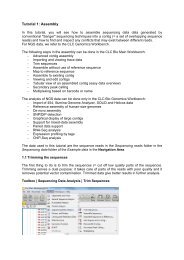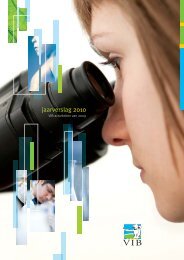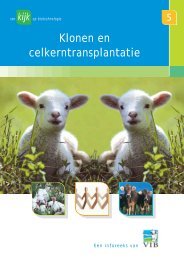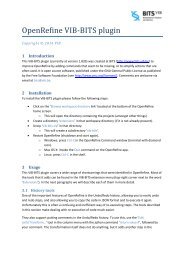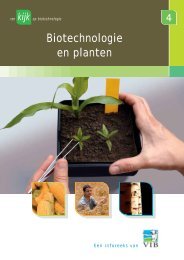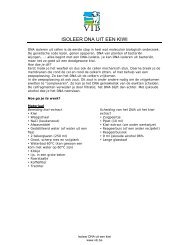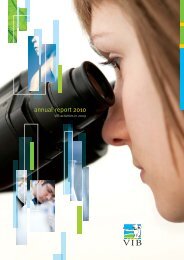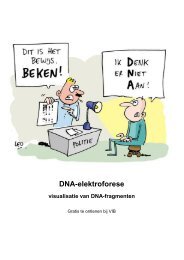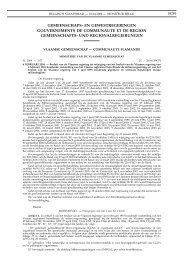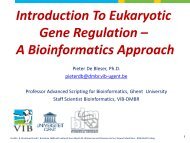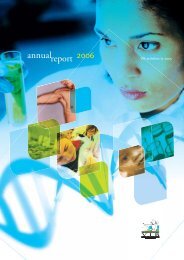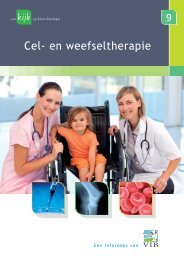Biosafety in the laboratory - VIB
Biosafety in the laboratory - VIB
Biosafety in the laboratory - VIB
You also want an ePaper? Increase the reach of your titles
YUMPU automatically turns print PDFs into web optimized ePapers that Google loves.
ANNEX 2:<br />
GUIDELINES FOR THE<br />
CLASSIFICATION OF<br />
GMO-ACTIVITIES<br />
Introduction<br />
These guidel<strong>in</strong>es are meant to offer help <strong>in</strong> <strong>the</strong> determ<strong>in</strong>ation of <strong>the</strong> appropriate conta<strong>in</strong>ment measures<br />
for activities with genetically modified organisms. In this annex a dist<strong>in</strong>ction is made between activities<br />
<strong>in</strong>volv<strong>in</strong>g micro-organisms and cells (chapter A), activities with plants (chapter B) and activities with animals<br />
(chapter C). The transformation of plants us<strong>in</strong>g Agrobacterium tumefaciens is classified as an activity<br />
with <strong>the</strong> micro-organism.<br />
The use of <strong>the</strong>se guidel<strong>in</strong>es<br />
These guidel<strong>in</strong>es offer especially help for determ<strong>in</strong><strong>in</strong>g <strong>the</strong> necessary conta<strong>in</strong>ment measures for activities<br />
with micro-organisms and cells (chapter A of <strong>the</strong>se guidel<strong>in</strong>es). In chapter A <strong>the</strong>re is a description of how<br />
to use <strong>the</strong> classification schemes. Also, <strong>the</strong> necessary def<strong>in</strong>itions of T1, T2 and T3 tox<strong>in</strong>s are given as<br />
well as <strong>the</strong> requirements for risk class 1 hostorganisms and vectors. For activities with transgenic plants,<br />
chapter B gives some guidance. Activities with transgenic animals and especially <strong>the</strong> comb<strong>in</strong>ation of <strong>the</strong><br />
use of genetically modified micro-organisms or cells with animals are difficult to classify. Chapter C gives<br />
some guidance for <strong>the</strong>se activities.<br />
Of course <strong>the</strong>re are cases that are not described <strong>in</strong> <strong>the</strong>se guidel<strong>in</strong>es. In such cases it is best to contact<br />
<strong>in</strong>ternal or external biosafety experts as given <strong>in</strong> annex 5 <strong>in</strong> this booklet.<br />
Sources<br />
These guidel<strong>in</strong>es have been developed from <strong>the</strong> guidel<strong>in</strong>es from <strong>the</strong> dutch genetic modification advisory<br />
committee (COGEM), as far as applicable <strong>in</strong> Belgium, and from <strong>the</strong> classification guidel<strong>in</strong>es <strong>in</strong> <strong>the</strong><br />
annexes of section 51 of Vlarem II.<br />
CHAPTER A. GUIDELINES FOR THE CLASSIFICATION OF ACTIVITIES INVOLVING<br />
GENETICALLY MODIFIED MICRO-ORGANISMS AND CELLS<br />
Classification rules<br />
On <strong>the</strong> follow<strong>in</strong>g pages classification schemes are presented that can be used to determ<strong>in</strong>e a first <strong>in</strong>dication<br />
of <strong>the</strong> necessary conta<strong>in</strong>ment level. As already expla<strong>in</strong>ed <strong>in</strong> chapter 3 and <strong>in</strong> <strong>the</strong> example <strong>in</strong> chapter<br />
7 of this booklet, this is only a first, but important step. To come to a f<strong>in</strong>al conclusion one still has to<br />
consider: (1) <strong>the</strong> environment to which <strong>the</strong> GMO would be exposed, (2) <strong>the</strong> type and <strong>the</strong> scale of <strong>the</strong><br />
activity, and (3) possible non-standard manipulations.<br />
The classification scheme is divided <strong>in</strong>to four parts:<br />
• Part 1: activities with host/vectorsystems that do or do not fulfill <strong>the</strong> criteria for categorisation <strong>in</strong> risk<br />
class 1 and activities with non-viral pathogenic hostorganisms<br />
• Part 2: activities <strong>in</strong>volv<strong>in</strong>g animal cells without viral vectors and with baculoviruses<br />
• Part 3: activities <strong>in</strong>volv<strong>in</strong>g animal cells <strong>in</strong> comb<strong>in</strong>ation with viruses or viral vectors<br />
• Part 4: activities <strong>in</strong> plant cells<br />
56<br />
<strong>Biosafety</strong> <strong>in</strong> <strong>the</strong> <strong>laboratory</strong>



